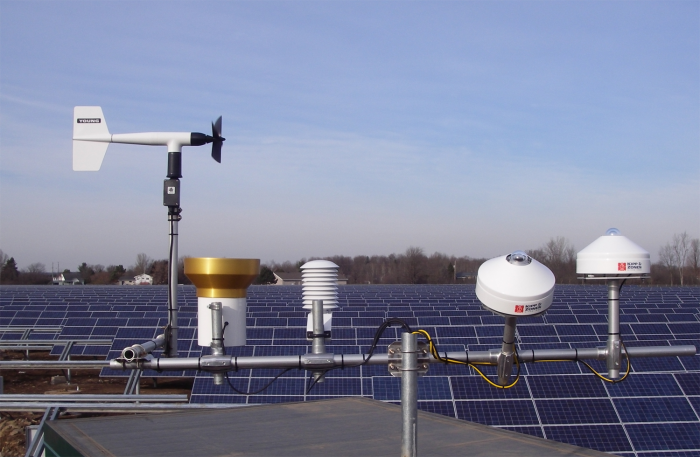



気候変動と汚染が世界的に重要な問題となっている中、政府と業界は技術と環境の変化に継続的に対応することが重要です。オンタリオ州政府は再生可能エネルギーに取り組んでおり、グリーンエネルギーおよびグリーン経済法 (2009 年) に基づいて固定価格買い取り制度 (FIT) プログラムを創設し、オンタリオ州での再生可能技術の開発と導入を奨励しています。FIT プログラムは北米初の再生可能エネルギー生産に対する包括的かつ保証された価格設定構造であり、再生可能エネルギー設備の多くの側面を標準化します。政府の再生可能エネルギー目標は 2018 年までに 10,700 MW (太陽光、風力、バイオマスからのエネルギーを含み、水力発電は除く) であり、目標達成に向けて順調に進んでいます。
再生可能エネルギーの大きな問題の一つは、発電量の変動性です。ご存知のとおり、風は常に吹くわけではなく、太陽は常に輝くわけではありません。一日を通して発生する可能性のある天候の変化を予測することは難しいため、電力網運営者にとっては問題となる可能性があります。この変動は設備のエネルギー出力に大きく影響し、その結果、顧客への電力供給にも影響します。
こうしたタイプの施設の現在の気象状況に関する情報を得るために、独立電力システム運用者 (IESO) は、一定規模以上のすべての風力および太陽光発電施設に、特定のパラメータを測定する気象観測所の設置を義務付けています。太陽光発電の場合、これは 5 MW を超えるすべての施設に適用されます。各太陽光発電所には少なくとも 2 つの気象観測所が必要であり、各観測所は全球水平放射照度およびアレイ面放射照度、気温、風速、風向、気圧、モジュール背面温度を測定する必要があります。センサーは太陽光発電フィールド内に設置され、可能な限り正確で発電自体に近い気象情報を提供します。各サイトは、プロジェクトの存続期間中、30 秒ごとに現在の気象状況を IESO に報告する必要があります。観測所の 2 番目の目的は、サイトのパフォーマンス データを所有者に提供し、プロジェクトの存続期間中、サイトが期待どおりに機能していることを確認することです。
CR1000 データロガーは現在、これらの要件をサポートするために多数の大規模太陽光発電プロジェクトで使用されています。Kipp & Zonen の CMP11 日射計と CVF3 ベンチレーターは、その優れた精度により、この用途の多くの太陽光発電気象ステーションの標準放射センサーとして急速に普及しました。データロガーは、サイトの監視制御およびデータ収集 (SCADA) システムと直接通信し、リアルタイムの測定値を提供します。一部の用途では、履歴情報を利用できます。CR1000 は通常、NL120 イーサネット モジュールを介して Modbus プロトコルで SCADA と通信します。SCADA オペレーターは、ヒューマン マシン インターフェイス (HMI) でリアルタイムの値と履歴値を確認して、現在および過去の気象を調べ、気象ステーション システムに存在する障害を検出できます。
オンタリオ州および全国で再生可能エネルギー部門が成長するにつれ、電力網のすべてのユーザーに利益をもたらす現在の気象を監視することの重要性も高まります。